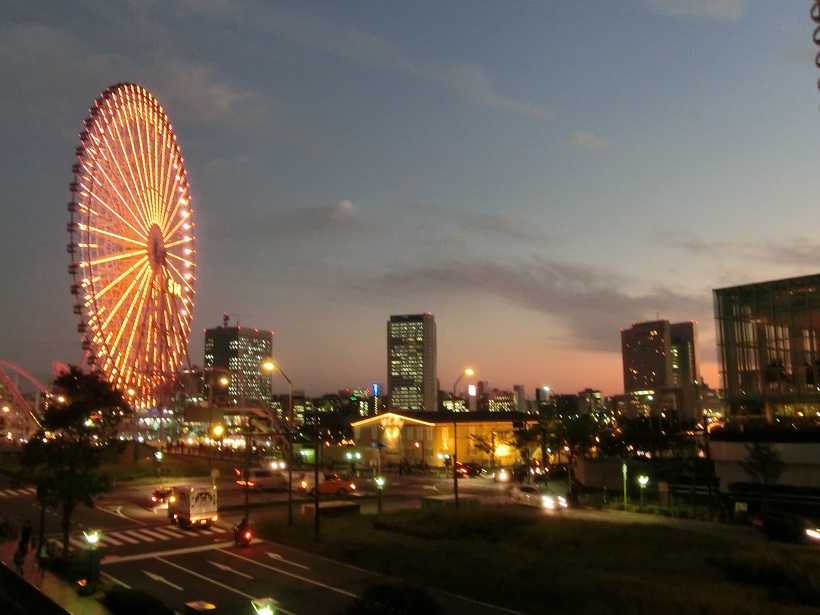|
Minato Mirai in Yokohama

|
Yokohama is the second largest city in Japan, following Tokyo.
During the Edo Age
(1603 - 1868)
, Japan was under national isolationism.
In 1853, Edo Bakufu, the Japanese feudal government headed by a Shogun, had contracts with the United States, the United Kingdom, the Netherlands, France and Russia to open five harbors. Yokohama, which used to be a poor fisherman's village, was selected as one of five harbors and this was the start of the development of Yokohama.
After World-War-II, the heavy industry developed along Tokyo Bay. As Yokohama has a good harbor, Yokohama also developed because of foreign trading by ships. At the harbor in Yokohama, a railroad yard and shipbuilding yards were located. However, Japan's main industry has switched to the tertiary industries, this area became not active nor attractive.
"Landmark Tower"

|
"Yokohama Grand Intercontinental Hotel"

|
Minato Mirai Area has been re-developed since 1985.
Minato Mirai Area is located to the east side of Sakuragi-Cho Station on the JR Negishi and Yokohama Subway lines. If you take the east side exit of JR Sakuragi-Cho Station and walk to the small artificial inlet of Yokohama Harbor, you will see tall buildings in front of you, as shown in the above pictures.
The "Landmark Tower" building and the "Yokohama Grand Intercontinental Hotel" are the landmark of Minato Mirai Area. These buildings are used for modern shopping malls, for high class hotels and for offices. Also, an amusement park was also built. With the construction of these buildings, Minato Mirai Area has been reborn. Now, more than 80 million people and more than 11 million sightseers visit this area each year.
Please refer the page of "Landmark Tower" for more detail:
http://handejapan19.html.xdomain.jp/TravelDestinations/Kanto/LandmarkTower_E.html
You will find an old and big metal object, displayed at the harbor. This is a part of an air compressor made in 1918, in the United States. Before the 1970s, Japan had been following developed countries, and many advanced products were imported from Western countries.
You will also find a white sailing ship.
The name of this beautiful ship is "Nippon-Maru", "Nippon" means Japan in Japanese. The ship was built in 1930 and used as a navigation training ship. The nickname of the ship is "White Swan on the Pacific Ocean" or "Her Ladyship of Sea".
The narrow waterway, where "Nippon-Maru" is located, continues to the Yokohama Grand Intercontinental Hotel.
The narrow waterway used to be the first dock of the Yokohama Dock Company, built in 1898. The dock was built to conduct maintenance of ships which visited Yokohama for trading between foreign countries and Japan in the Meiji Age
(1868 - 1912)
.
|
|
"Nippon-Maru" and the first dock of Yokohama Dock Company were designated as important properties of Japan.
If you walk along the waterway towards the Yokohama Grand Intercontinental Hotel, you will find the second dock of the Yokohama Dock Company on your left.
You will easily understand how the dock was big. Also, it is very interesting the contrast between modern buildings and an old
cultural heritage of Japan, when Japan was a developing country. The second dock is also designated as an important property of Japan.
If you further walk along the waterway, you will reach the "Kokusai-Bashi" Bridge, the international bridge, just in front of the Yokohama Grand Intercontinental Hotel. You will see the Landmark Tower, the tallest building shown in the below picture, when you look back. Also, you will see the Queen's Square in front of the Landmark Tower.
The below pictures were taken from the Yokohama Grand Intercontinental Hotel in November 2011. It was just after the sunset. The ferris wheel at Yokohama Cosmo-World was illuminated, and sky had been changing its color from blue to red. It was a very beautiful sunset.
|
"Ferris wheel at Yokohama Cosmo-World"

|
"The Yokohama Bay Hotel Tokyu"

|
|
I had an opportunity to be on a balcony of the Yokohama Bay Hotel Tokyu. It was at night and the night view of the "Yokohama Grand Intercontinental Hotel" was magnificent.
In Minato Mirai Area, you will see one of the most modern cities in Japan, but you will also find a couple of sites of Japan under industrialization.
Ferry services are available from Minato Mirai Area to Yokohama Station, also to Yamashita Park. You will also see Minato Mirai Area from the sea, as shown in the top picture.
|
|

 Home Page in Japanese: "Shane's HomePage"
Home Page in Japanese: "Shane's HomePage"

 Home Page in Japanese: "Shane's HomePage"
Home Page in Japanese: "Shane's HomePage"